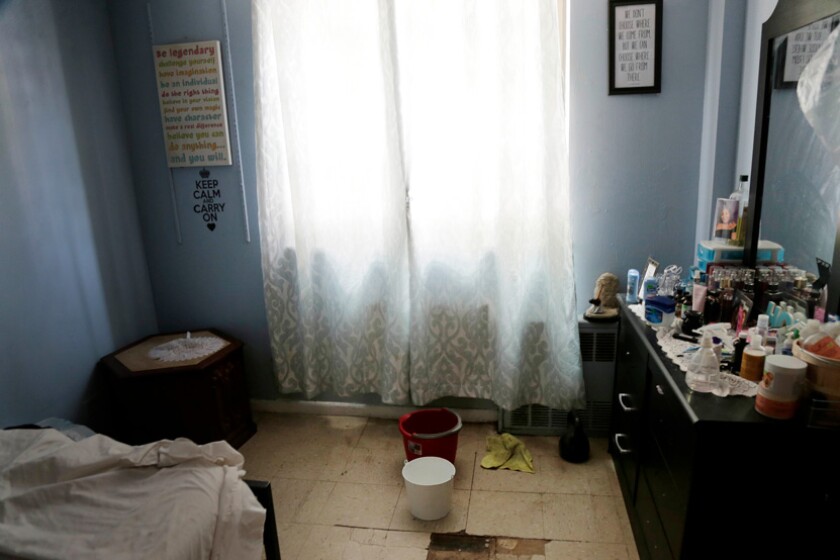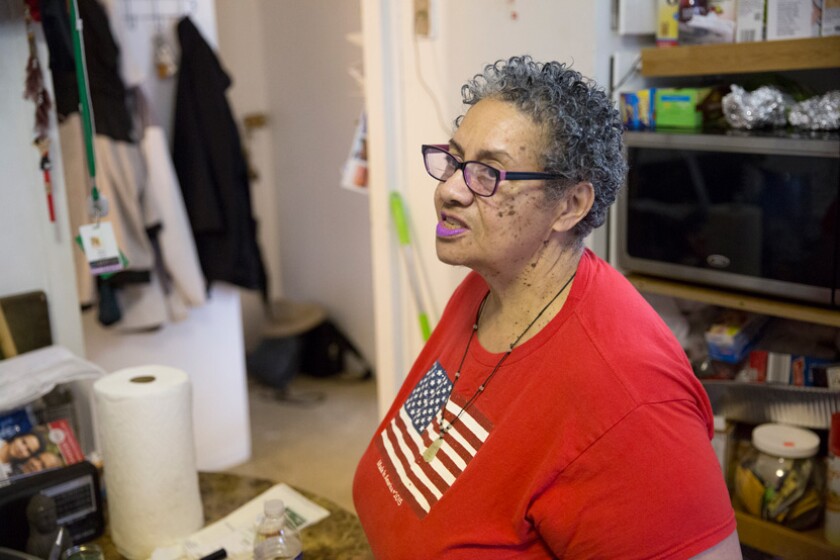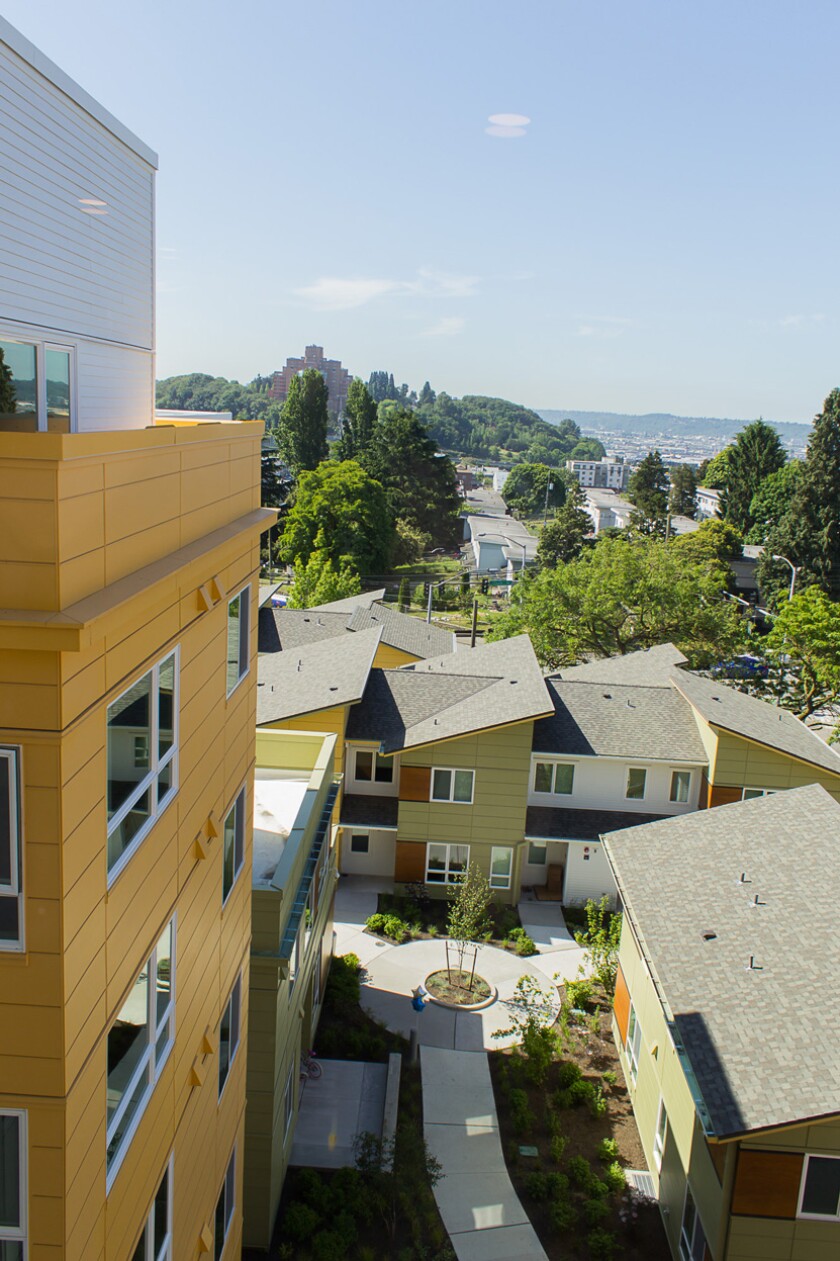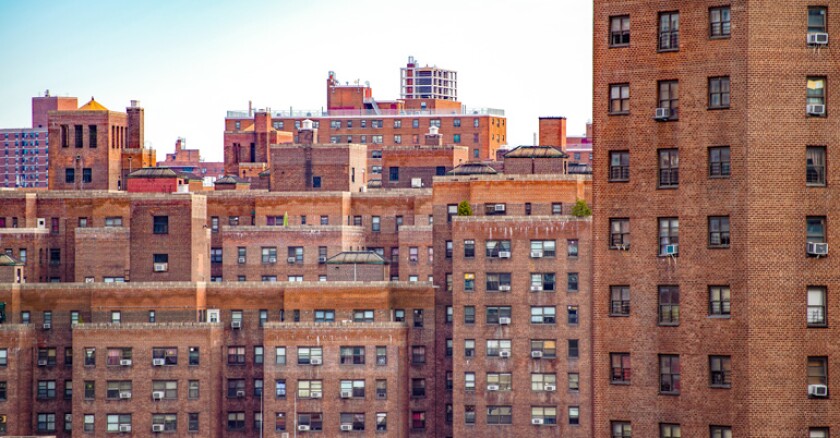Problems like the one in Vazquez’s apartment are common across the buildings owned by the New York City Housing Authority (NYCHA). Mold, rat infestations, lead paint, leaky roofs and broken elevators plague the 130,000 apartment units that make up the biggest public housing system in the nation. For decades, NYCHA has neglected maintenance of its buildings. It’s been estimated that the agency needs to invest $31.8 billion to make its buildings fit for the people who live there. “I think there was a culture of not complying with things,” says Steve Edwards, an attorney for the plaintiffs in one of two lawsuits filed against NYCHA in the last six years. “They just thought they could get away with it.”
The situation in New York is a test for public housing writ large. The United States is faced with an acute housing shortage, and in cities around the country, housing authorities have long been the primary provider of shelter for the working class and the poor. But can a system that has for decades been underfunded, the target of derision and heavy-handed demolitions, remake itself into a solution?
In 2013, a test case was put forward by three tenants and two housing advocacy nonprofits, Upper Manhattan Together and the South Bronx Churches. They claimed NYCHA routinely offered up insufficient remedies for persistent mold across its massive network of apartments. Instead of treating the inadequate plumbing that was the source of the mold, Housing Authority workers wiped down walls and cleaned only those areas that tenants could see.
That negligence led to a consent decree. The Housing Authority was placed under a court order mandating that it address the source of the mold and fix the persistent plumbing failure that was causing the mold in apartments across the city. In 2015, the plaintiffs filed a motion that NYCHA was not complying with the consent decree. The court agreed and appointed a special master who also found that the agency was failing to address the mold. “NYCHA has been out of compliance with the consent decree from the day it was entered by this court,” U.S. District Judge William Pauley wrote. “NYCHA’s justifications for its failure to comply are inadequate, and the attitude of NYCHA officials appears to be one of indifference.” No member of NYCHA’s management bothered to attend a hearing on the plaintiff’s motion.
“NYCHA just didn’t care. They agreed to the consent decree and then ignored it and did nothing to comply with it,” says Edwards, who represented the plaintiffs in the mold lawsuit. “And when it became clear to them they were going to get in trouble, they essentially couldn’t comply. They didn’t have competent people.” This past November, Pauley approved a second, much stronger consent decree. NYCHA promised to abide by it.

In some New York public housing apartments, residents use buckets to catch drips of water from the ceiling. (AP)
At the same time NYCHA was being sued over mold, the federal government was looking into the agency’s botched efforts to deal with lead paint in its housing complexes. The investigation found repeated efforts by the agency to conceal its failure to remove lead from its properties. NYCHA filed misleading reports on its lead paint abatement program, and as the government dug deeper, its probe expanded beyond lead to issues around rat infestations, broken elevators and general living conditions in NYCHA buildings. Fresh off the legal battle around the prior mold case, Judge Pauley rejected a consent decree between NYCHA and the federal government on lead removal. Pauley said the consent decree on lead would do little to improve living conditions for the public housing residents. The decree lacked deadlines and timelines for the Housing Authority’s appointment of a court-ordered monitor, and did not insist on immediate plans to address the broader problems in public housing.
In January, the federal government, the city and the state came to an agreement that forces the city to hand over control of the agency to a federally appointed monitor and invest $2.2 billion in capital improvements in the next 10 years. But the agreement falls far short of what will be needed to bring public housing in New York into compliance with the standards the federal government and the courts have asked for. While the feds will oversee the operation and rehabilitation of public housing in New York, they aren’t making a firm commitment of money to the improvements.
U.S. Sen. Charles Schumer and Rep. Nydia Velazquez, both New York Democrats, have asked the Trump administration and HUD Secretary Ben Carson for $1.2 billion in federal aid to help fix the city’s housing projects. But in March, Trump released a proposed budget that seeks to eliminate HUD’s Public Housing Capital Fund, the source of funding for the capital improvements needed in New York. At the same time, HUD is seeking to raise rents for public housing tenants nationwide. The announcement drew a strong rebuke from New York Mayor Bill de Blasio and from Kathryn Garcia, the interim CEO of NYCHA. “We will not stand by,” Garcia said, “as the federal government tries to abandon the hundreds of thousands of New Yorkers who rely on this funding.”
This is not the way things used to work in public housing. Early in the 20th century, as cold-water flats and crowded tenements became ubiquitous in cities across the industrial United States, the federal government looked to replace squalid conditions with housing fit for working-class families. It funded the construction of huge public housing concentrations, with buildings as high as 16 stories and vast tracts of land leveled to form what became known as “superblocks.” The stripped-down design of public housing followed the modernist concepts of Swiss designer Le Corbusier. But more importantly, Congress and local political leaders favored the skyscraper designs because they were cheap, writes Ben Austen in his book High-Risers, which tracks the history and decline of Chicago’s Cabrini-Green Housing project. Poor design, cheap materials and shoddy construction often left tenants stranded in high-rises where the elevators routinely broke, and where they were assaulted by the stench of rotting garbage when the incinerators failed. The original designs for the massive Queensbridge Houses in New York’s Long Island City, developed by NYCHA, included elevators that stopped only on the first, third and fifth floors. The elevators now stop on one through five, but still aren’t accessible to residents on the top floor of the six-story buildings.
Public housing was almost entirely segregated. Harold Ickes, the secretary of the interior under President Franklin Roosevelt, suggested what became the neighborhood composition rule, which made segregation expressly legal. It was a concession to conservatives in Congress who preferred not to build public housing for black citizens at all. The few public housing complexes that were integrated seldom remained integrated for long. When the federal government offered attractive incentives to home buyers, white families left en masse for the suburbs. Federally backed mortgages were made available to them that were not available to people of color. White middle-income residents were replaced in public housing by much poorer black and Latino residents.

In a March town hall meeting with a HUD executive, Marilyn Keller, who lives in public housing in Queens, described how her apartment has no heat or hot water. (AP)
Like so many people looking to escape slum apartments, Diana Vazquez landed in the projects with a sense of hope for what her new apartment would bring her. Prior to living in the Jefferson Houses, Vazquez and her two sons lived in a tenement on the Upper East Side of Manhattan. The heat didn’t work. Vermin overran the property. “I was coming out of an apartment building where I had to live with rats climbing up on my stove and I had a leak in my bathroom,” Vazquez says. “I didn’t have any heat and had to sit in front of my oven with coats on me and my children, and that’s how we often slept.” This wasn’t uncommon in the late 1970s and early 1980s. From the Bronx to Harlem to Brooklyn, landlords were leaving apartments in a constant state of disrepair. Property values sank. And where some landlords simply didn’t repair their buildings, others lit their properties on fire to collect the insurance money. In 1981, four years after television viewers of the World Series saw burning buildings in the Bronx background, Vazquez and her sons would escape similar deplorable conditions. She was hopeful when she first moved into the Jefferson development. “I had almost given up because I had applied for public housing for years,” she says. “When we found out we were getting a place, I was excited. The projects was a step up.”
Even as the 1980s found Harlem inundated with crack cocaine and crime, Jefferson Houses proved to be an oasis. The grounds and the building were kept up. It was rare to see people smoking crack or even marijuana in the hallways or in the lobby. But that would soon change. The federal government’s outlay for maintenance had remained flat for decades. Adjusted for inflation, HUD now spends one-third the amount of money on housing assistance that it did in 1970, according to a congressional review of the agency’s spending conducted in December. The exodus of middle-income tenants who paid more in rent than their low-income neighbors ate away at revenue needed to maintain the properties. The federal government’s reluctance to keep up the housing projects transformed them into the very slums they were designed to replace. Vazquez now complains about open drug use and a lobby door that didn’t lock for an entire year.
As in New York, Chicago’s public housing was constructed on superblocks. Massive and often isolated, these vertical slums became symbols for the urban decay happening in and around them. For both critics and advocates of housing projects, Cabrini-Green Homes, the massive housing complex just north of Chicago’s Loop, became the symbol of all that had gone wrong in public housing. It was home to more than 15,000 residents at its peak and was the base of operations for a violent street gang whose foot soldiers routinely rained down bullets on cops, rivals and fellow residents from their perches atop the high rises. In 1981, Mayor Jane Byrne spent three weeks living in the complex and returned with an account of the horrid conditions. Cabrini was where the nation learned of Girl X, the 9-year-old who was kidnapped in a hallway, repeatedly raped, assaulted and left for dead. Near the end of Cabrini-Green’s run, the complex served as the backdrop of the 1992 horror film Candyman. “We had hit bottom,” says Bruce Katz, a fellow with the Lindy Institute for Urban Innovation at Drexel University. “There really was a sense of urgency.”
With as much as 10 percent of the nation’s public housing stock in deplorable condition, Congress in 1992 both authorized and appropriated the first money for HOPE VI (Homeownership Opportunities for People Everywhere). HUD would pay housing agencies to knock down the worst of the complexes and replace them with less-dense homes where low- and middle-income residents would live side by side. The superblocks were broken up into walkable streets and low-rise buildings reminiscent of the neighborhoods of a much earlier time. Across the country, nearly 500,000 units were demolished under HOPE VI. The units were not replaced one-for-one. Instead, low-income residents who didn’t return to a rebuilt housing project were steered to the expanded Section 8 program that offered vouchers to pay rental expenses. “The question was whether you could begin to not just redo public housing, but to actually regenerate a community,” Katz says. In the end, the results were mixed.
Where scale had been the goal in the construction of public housing towers, scale also became the driving force behind the teardowns. Chicago led the way. Starting in 1995, Cabrini-Green began being demolished. Over the next two decades, as part of the city’s controversial Plan for Transformation, some 18,000 units across the city were eliminated. The pattern of demolition and displacement was perhaps most pronounced in the Bronzeville neighborhood on Chicago’s South Side. The projects there had become cauldrons of crime, and more than 10,000 units in the neighborhood came tumbling down. As the years went on, private investors showed some interest in developing middle-income housing on the same sites. But the 2008 housing crisis dried up credit. Redevelopment slowed to a crawl and then stopped cold. Of the nearly 7,000 units the Chicago Housing Authority promised to build in Bronzeville, only 547 were built, according to the housing authority’s own data. From 2000 to 2010, 180,000 black residents left Chicago, an exodus driven in large part by the mass destruction of public housing.
But while HOPE VI reshaped public housing in Chicago and cities across the country, it barely made a dent in New York City’s public housing stock. The density of the metropolis, the price of land and the cost of temporarily housing residents during any massive rehaul made such plans next to impossible to execute. “Housing is an expensive commodity. It’s a big sunk cost,” says Peter Dreier, who chairs the Urban and Environmental Policy Department at Occidental College. “There’s land. There’s the building cost. And then there’s the financing.”
Dreier oversaw Boston’s efforts to build affordable housing, which it did with much more success than New York. Many of those efforts happened before HOPE VI rolled out. But even with the federal dollars, it’s hard to pencil out an affordable housing project in New York City. And that became next to impossible when HUD decided to give New York City barely half as much HOPE VI funding, $88 million, as it did Boston, which received $157 million from the program. In the end, New York City did build a handful of mixed-income units. But the city didn’t engage in the massive teardown and renovation seen in Chicago and elsewhere. Because New York City stuck with its traditional public housing scheme, mostly serving the poor, NYCHA could not bring in the revenues to keep up its buildings. In the end, it left Vazquez, along with the hundreds of thousands of other residents in NYCHA housing, waiting for yet another federal bailout.
For all the criticism of HOPE VI -- that it pushed many black families out of subsidized housing and scattered the rest in faraway neighborhoods -- the program did come with some benefits. For example, the families who were moved from the Chicago projects into the expanded Section 8 voucher program found that their children fared much better. Once they reached adulthood, they were 9 percent more likely to be employed and earned 16 percent more, according to a University of Virginia study. “Changing the housing mix was the right intervention,” Katz says. “What should have been done, and was done in some places, was better staging of families during relocation.”

Seattle’s Yesler Terrace complex shows how HOPE VI planners had envisioned the policy being used to entice private developers to build market-rate units alongside public housing. (Seattle City Council)
Where Chicago and New York stand out as examples of the limitations of HOPE VI, the city of Seattle leveraged the program in the way the policy’s planners hoped for from its inception. HOPE VI injected $35 million in federal capital in 1999 to launch a transformation of Yesler Terrace, a public housing complex in the city. The federal money was the leading edge of investment in the neighborhood. More than $250 million in private investment rolled into the housing complex. The Seattle Housing Authority sold some of the land to private developers who built market-rate rental properties and sold market-rate homes that sit among public housing. The new complex, which took 11 years to complete, went from 481 units to 895. The money from the land sale funded the renovation of the public housing. “The benefits we have are land -- and valuable land,” says Andrew Lofton, deputy executive director of the Seattle Housing Authority. “It’s a tremendously valuable real estate site.”
Seattle’s model is one familiar to European policymakers. In Europe, it’s common to leverage the value of public land to finance development of everything from public housing to transit. One innovation popular in Europe is the public asset corporation, an entity that owns public land, public utilities and transit systems. When the time comes to pay for new housing and other infrastructure, those corporations can use the sale or lease of the property to raise money for capital costs.
Yesler Terrace was also one of the first communities targeted for investment under President Barack Obama’s Choice Neighborhoods program. Where previous public housing programs focused on the physical buildings, Choice Neighborhoods expanded the effort to community services. Yesler Terrace has spent $4.5 million on education, employment and health programs. And the redevelopment of the site is centered around a streetcar line. The idea is to better connect residents in Yesler Terrace to jobs, schools and life outside the neighborhood.
NYCHA’s immediate future will be a fiscal management balancing act. HUD is unlikely to commit more money to the agency in the near term. NYCHA will have to improve management of its limited resources. “I think NYCHA needs to hone in on triaging better,” says Ray Lopez, director of programs at Little Sisters of the Assumption, a community services nonprofit located a block from the Jefferson Houses project. “Instead of reacting to the tenant complaints, they need to cluster complaints better and have a better idea of the condition of these buildings.”
Just as when public housing was first built, a crucial question remains about where and how to house the working-class people who are vital to making a city or community succeed. “The people who clean the floors, and take out the garbage, and wash the dishes, and type the letters, and take care of the streets -- a lot of those people live in NYCHA housing,” says Edwards, the plaintiffs’ lawyer in the mold suit. “If you want those people to serve you, you have to give them someplace to live.” The sheer magnitude of the problem, plus the fiscal conservatism that has limited federal aid to housing for the past four decades, might force NYCHA and HUD to explore other options, such as the ones used in Europe and Seattle, to rehabilitate public housing. As Katz likes to say, with a $31.8 billion problem, “you can’t tax your way out of it.”









